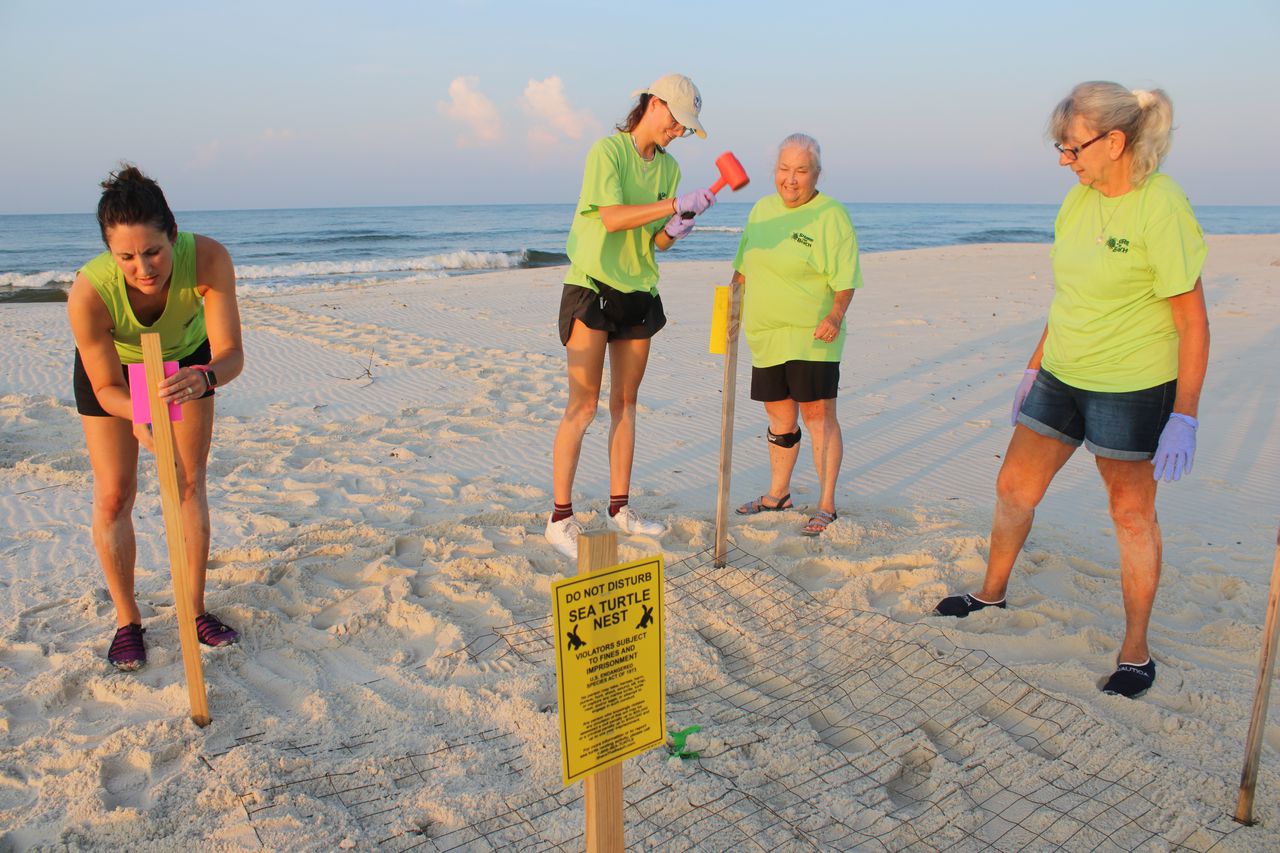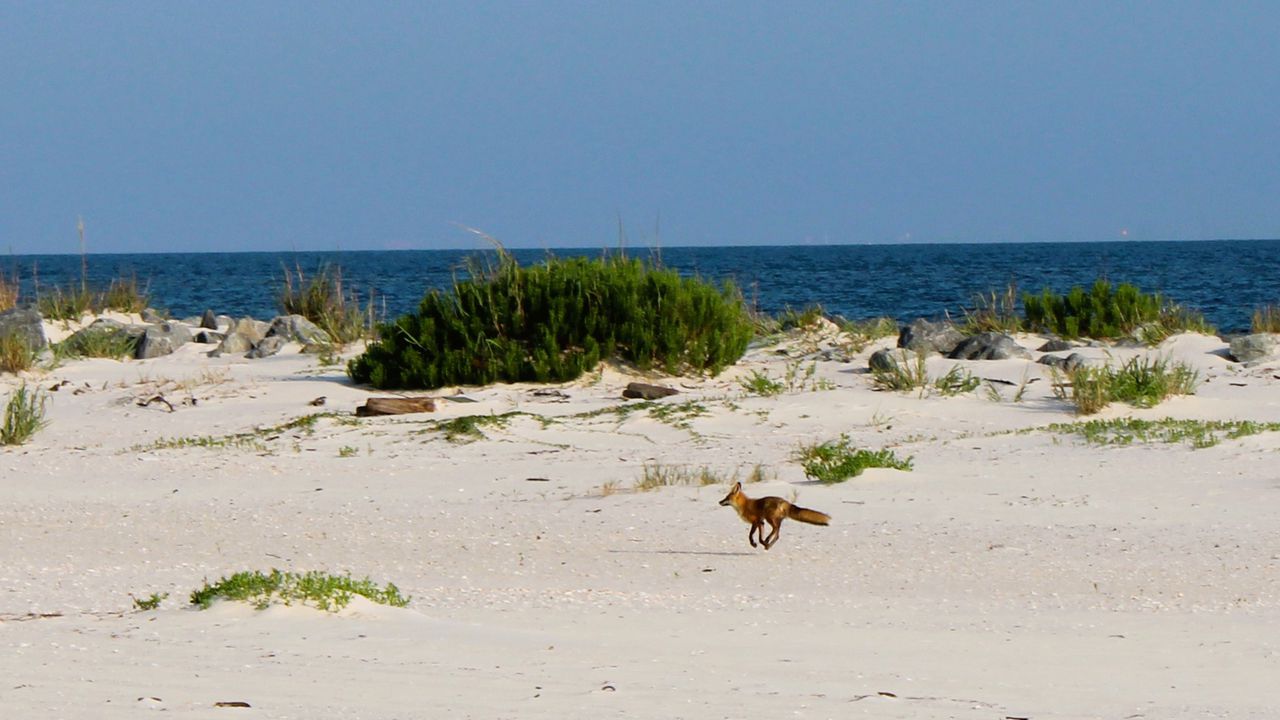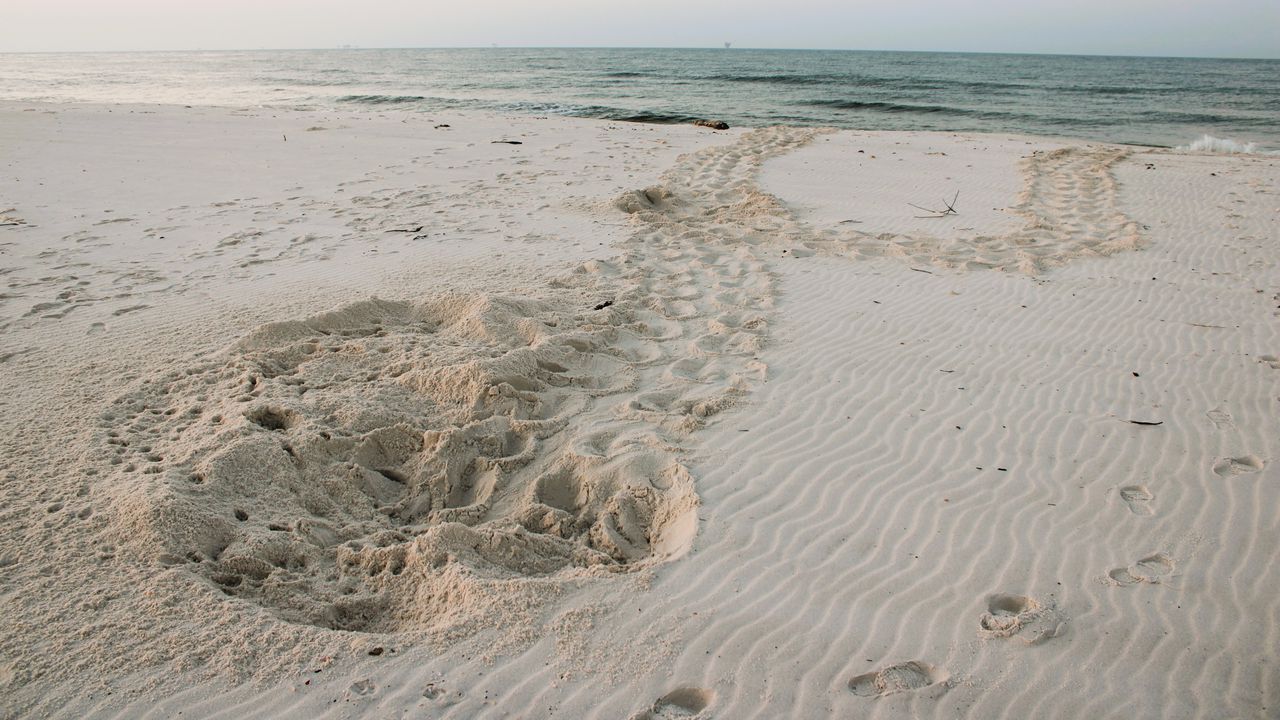Dawn patrol: To save sea turtles, these volunteers hit the beach early
The search begins at sunrise, with eight-and-a-half miles of desolate beach to cover. By the time the small party of volunteers disbands three-and-a-half hours later, they’ve secured two new sea turtle nests and possibly saved one of them from drowning.
That’s one small piece of one day in the life of Share the Beach, Alabama’s sea turtle conservation program. The effort managed by the Alabama Coastal Foundation (ACF) recently created a stir with news that volunteers had, for the first time, documented evidence that a green sea turtle had laid a clutch of eggs on Dauphin Island.
That green turtle might have gotten the rock-star treatment if she’d hung around to take credit for her work. But as a Wednesday sweep of Dauphin Island’s west end showed, the 18-year-old effort isn’t about making a one-time splash. It’s a meticulous, methodical volunteer-driven approach to making a difference one fragile cluster of eggs at a time.
Among other things, that means getting up early. Turtles lay their eggs by night, so by the time the sun rises, the first wave of predators have already had their shot. By the time Sara Johnson pulled up to the morning’s first new “crawl,” there already was a reminder of that.
“We’ve got fox prints all over it,” she said.
Just a little while earlier, at 5:45 a.m., Johnson had pulled into the parking lot at Dauphin Island’s West End Beach to pick up the other three people in her crew: ACF Administrator Anna Yancy, in her first season as a Share the Beach volunteer; Desiree Duke, a retired director of the Mobile County Public School System’s Environmental Studies Center; and island resident Kathy Till.
Their motivations varied. Yancey wanted to get some experience in the hands-on side of ACF work. Duke, as an educator specializing in nature, said she always had “a turtle thing.” Till said she’d been motivated by the desire to volunteer for something on the island.
While the same people don’t necessarily patrol every day, the task this group took on required more than a casual effort. The West End Beach isn’t at the western end of the island. It’s at the western end of the inhabited part of the island. Beyond that, the west end is a slender spur that’s basically a wilderness. It’s narrower in some places than others, but it’s never very wide or very high. Any question of whether it could be developed was settled by Hurricane Katrina, which blew a gap in it, the “Katrina Cut,” highlighting just how fragile it was. It was privately owned until recently, but in 2021 the state purchased more than 800 acres using around $8 million in funds made available through the RESTORE Act, which governs money collected in fines and penalties from the Deepwater Horizon Disaster.
A project summary provided by NOAA describes the area as “a diverse coastal habitat made of dunes, marshes, and beaches.” According to the summary, Mobile County and the town of Dauphin Island are working to develop a management plan.
For Johnson and her crew, the strip of sand close to the water was the focus. Sea turtles swimming northward pull themselves out of the Gulf of Mexico and across the sand using their flippers, which leave a distinctive track known as a crawl. They’re easy to spot, though the turtles don’t necessarily make it obvious exactly where they hid their eggs: They scootch around, flinging loose sand over a much wider area.
A sea turtle “crawl” found on the west end of Dauphin Island illustrates the turtle’s path in from the water, at left, her nesting site, and her return to the Gulf of Mexico.Lawrence Specker | [email protected]
Maybe it pays off. Though the site was peppered with fox prints, and the irregular path of the turtle made Johnson wonder if foxes had been harassing the mother turtle, there was no sign the predators had gotten what they wanted: No burrows, no remnants of eggs that had been dug up and eaten.
The team drove in long stakes to mark the perimeter of the site, roughly a 10-foot square, then gently dug just deep enough to establish exactly where the clutch of eggs was. Johnson led the way, feeling for a telltale vein of sand more loosely packed than the rest. “It’s extremely unlikely there’s going to be anything there,” she said, pointing at various areas. “It’s probably here.”
Following her guidance, Yancy uncovered the first couple of eggs. For the youngest member of the team, it was her first success: Up until now, she’d only been on hand for a couple of “false crawls” that turned up no eggs.
The couple of eggs briefly exposed were just the tip of the clutch. A turtle usually lays between 80 and 120, Johnson said, and volunteers have seen up to 150.
The crew went through a detailed procedure, recording data on a form. The pattern and width of the crawl marks tells a lot about the turtle. This one was 42″ wide, with an alternating left-right-left pattern. “That’s a larger loggerhead,” said Johnson.
The green turtle that recently visited had identified herself by a different pattern: Even crawl strokes and a messier distribution of thrown sand. The greens are herbivores, and Johnson said they tend to find their favored habitat and sea grasses farther to the east, so finding signs of one in Alabama is a novelty. “They occasionally drift this way,” she said.
Other measurements included the distance from the waterline and from the dunes, the depth of the eggs, and GPS coordinates. The team laid a six-foot-square section of wire fencing over the site and moved the stakes inward to pin its corners, roping off that tighter perimeter with brightly colored tape.
The wire is to keep the foxes out, Johnson said. Volunteers found they had to upgrade from four-by-four sections to deter these Dauphin Island foxes, but so far that has done the trick. Apparently they don’t like to tunnel in from the side. The mesh is large enough that turtle hatchlings easily can pass through, she said.
With the site all wrapped up, it was time to move on. “Nice work, ladies, nice work,” said Johnson.

Volunteers finish documenting and marking a fresh sea turtle nesting site on Dauphin Island’s west end. From left are Sara Johnson and Anna Yancy of the Alabama Coastal Foundation, retired educator Desiree Duke and island resident Kathy Till.Lawrence Specker | [email protected]
The small “Share the Beach” utility vehicle needed its low gear and its four-wheel drive to cover the sand, and even so its footing felt loose. On the long cruise to land’s end and back, there was little sign of human activity: A red-hulled shrimp boat working far offshore, a couple of recreational fishing boats at the tip.
One of the day’s two nests was a short distance from the water in the area of the Katrina Cut, and this prompted some concern. The cut was filled in with rocks, and these promoted the accumulation of sand. The cut “healed,” but it remains a low and narrow spot.
“We really only relocate nests when they’re below the average daily high tide line,” Johnson said. “We don’t relocate nests if they’re at risk of getting washed over for storms. But the west end washes over for the tiniest reasons. This area in particular, here at the cut, what used to be the Katrina Cut, completely covers in water. We’ve had to take the UTV up to the rocks to get around it.”
She called a state biologist for a consultation, which confirmed her impulse to move the nest. After picking a new site nearby, farther back from the water but higher up on the slope of a low dune, they carefully transferred 128 eggs. The relocated clutch then got the same measurements, markings and armor plating as the other one.
Sometime during the process, a fox went cantering past, heading from the direction of the public beach toward the wilderness to the west. The animal seemed neither particularly concerned about being in plain view of the human interlopers, nor interested in getting closer to them.

A fox runs along the west end of Dauphin Island on June 28, 2023. Foxes are among the predators that threaten sea turtle nests on the beach.Lawrence Specker | [email protected]
Most days this route is finished by 7:30 a.m., Johnson said, but today it was well after 9 a.m. Either way, it’s a small part of a gargantuan effort. Originally founded by the Friends of the Bon Secour Wildlife Refuge in Gulf Shores, Share the Beach has grown under the ACF to include a daily sweep of all 47 miles of Alabama’s coastline. The active nesting season runs from the start of May to the end of August; the eggs incubate from 50 to 60 days before hatching, so volunteers keep watching the nests until the end of October. (The ACF says it has filled its teams for this year, but anyone interested in participating can sign up for its newsletter to get updates about joining in next year.)
The nests found today were the 17th and 18th of the year on the west end. The Share the Beach program’s biggest year was 2016, according to ACF statistics, when 237 nests were found. Recent years haven’t come close to that: 99 in 2020, 66 in 2021, 74 in 2022.
Sea turtles take 15 to 20 years to mature, so the program is just getting to the point where organizers might hope to see an upturn, as hatchlings saved by the program return to lay eggs of their own. But so many other factors can affect a turtle’s life that it will be hard to pinpoint the impact of this one effort.
That said, the volunteers know they’re tipping the odds in favor of the hatchlings. That’s as plain as a fox’s footprints in the sand.
At one point in the morning, Johnson checks her phone for updates. More nests have been found in Baldwin County: Two at Bon Secour, and another at Alabama Point. “We’re at a five-nest day already,” she said. “It makes me so happy.”
For more on the Share the Beach sea turtle conservation program, visit the Alabama Coastal Foundation site www.joinacf.org. If you think you’ve found a fresh turtle nesting site, call 866-SEA-TURTLE.
